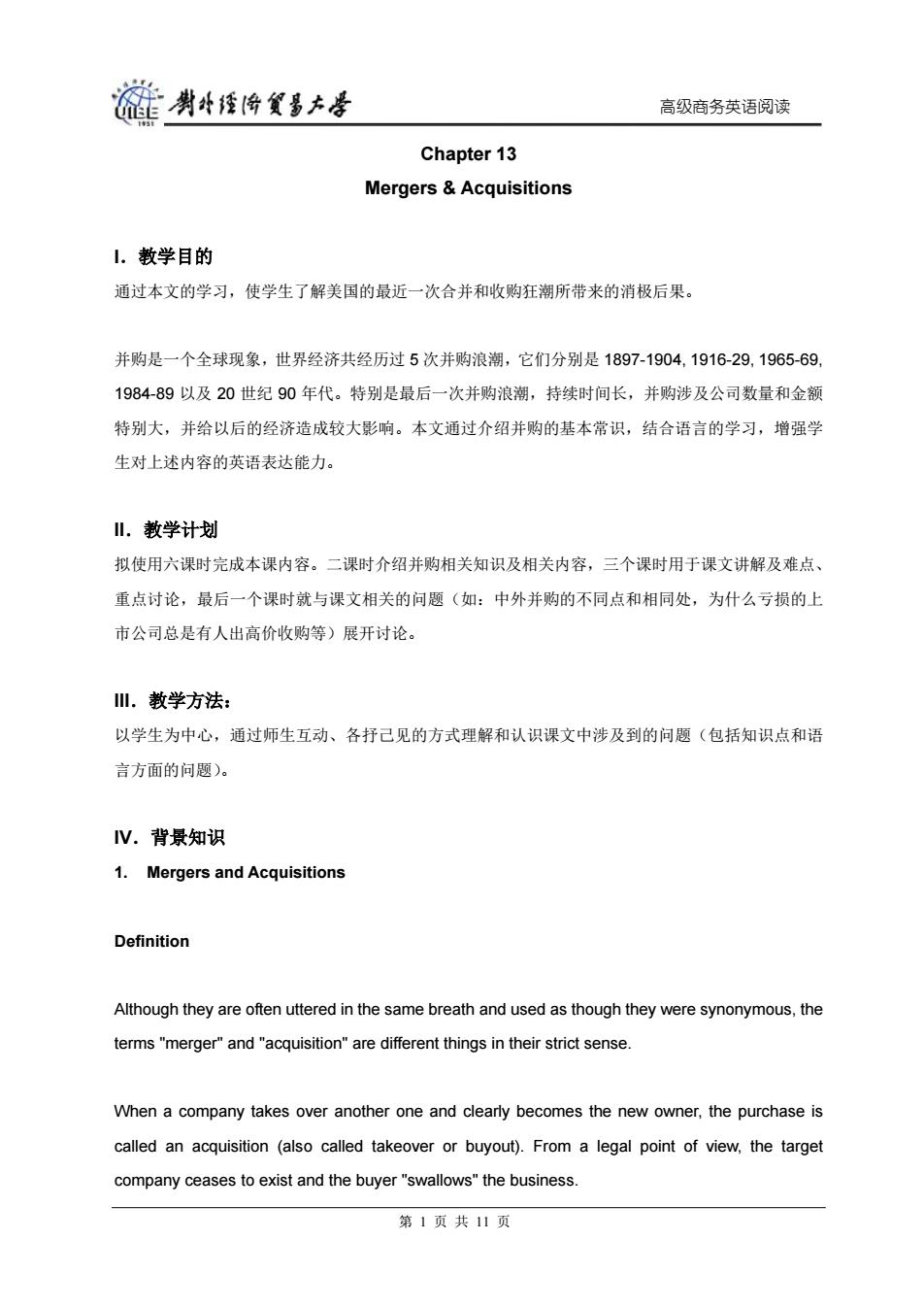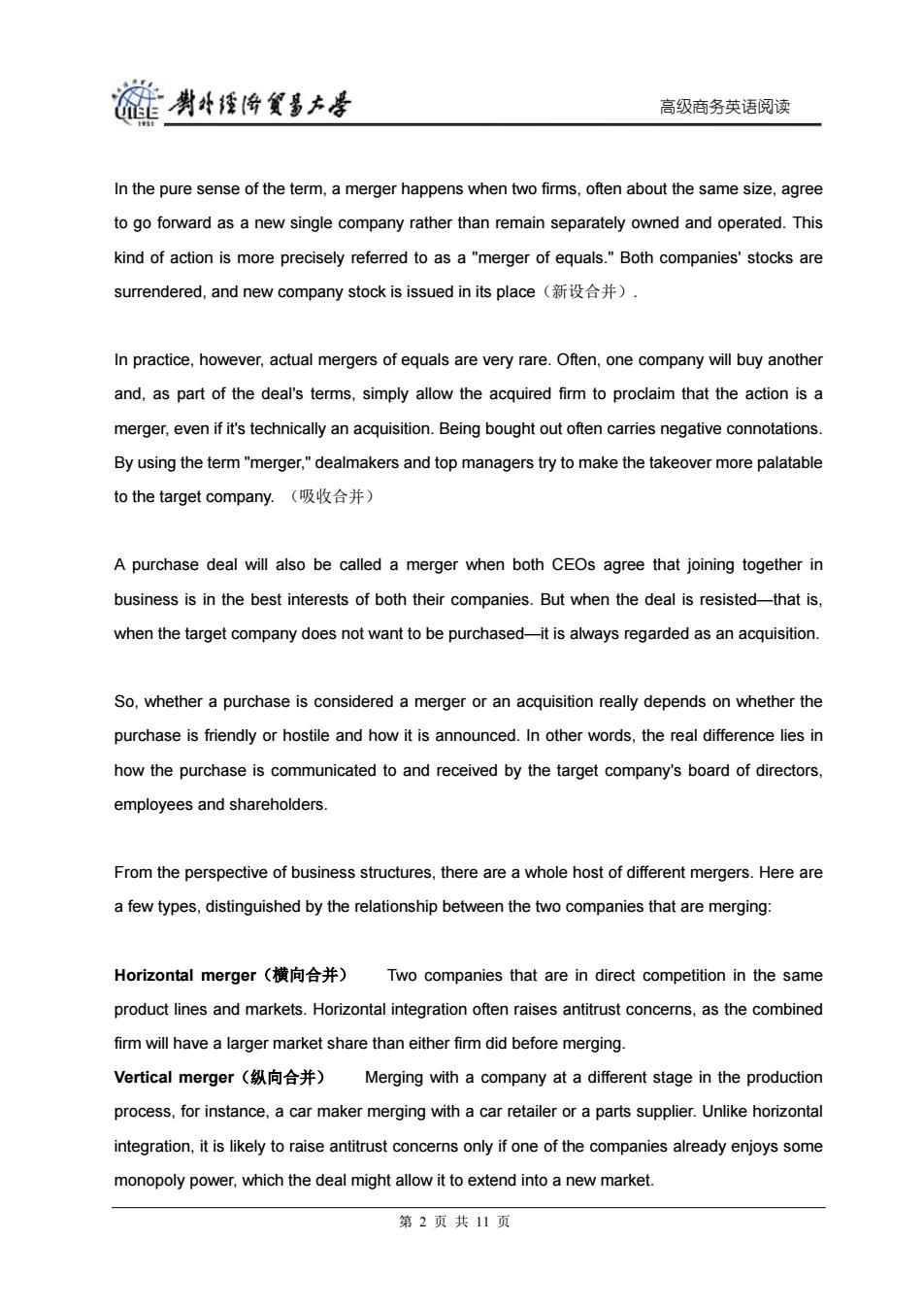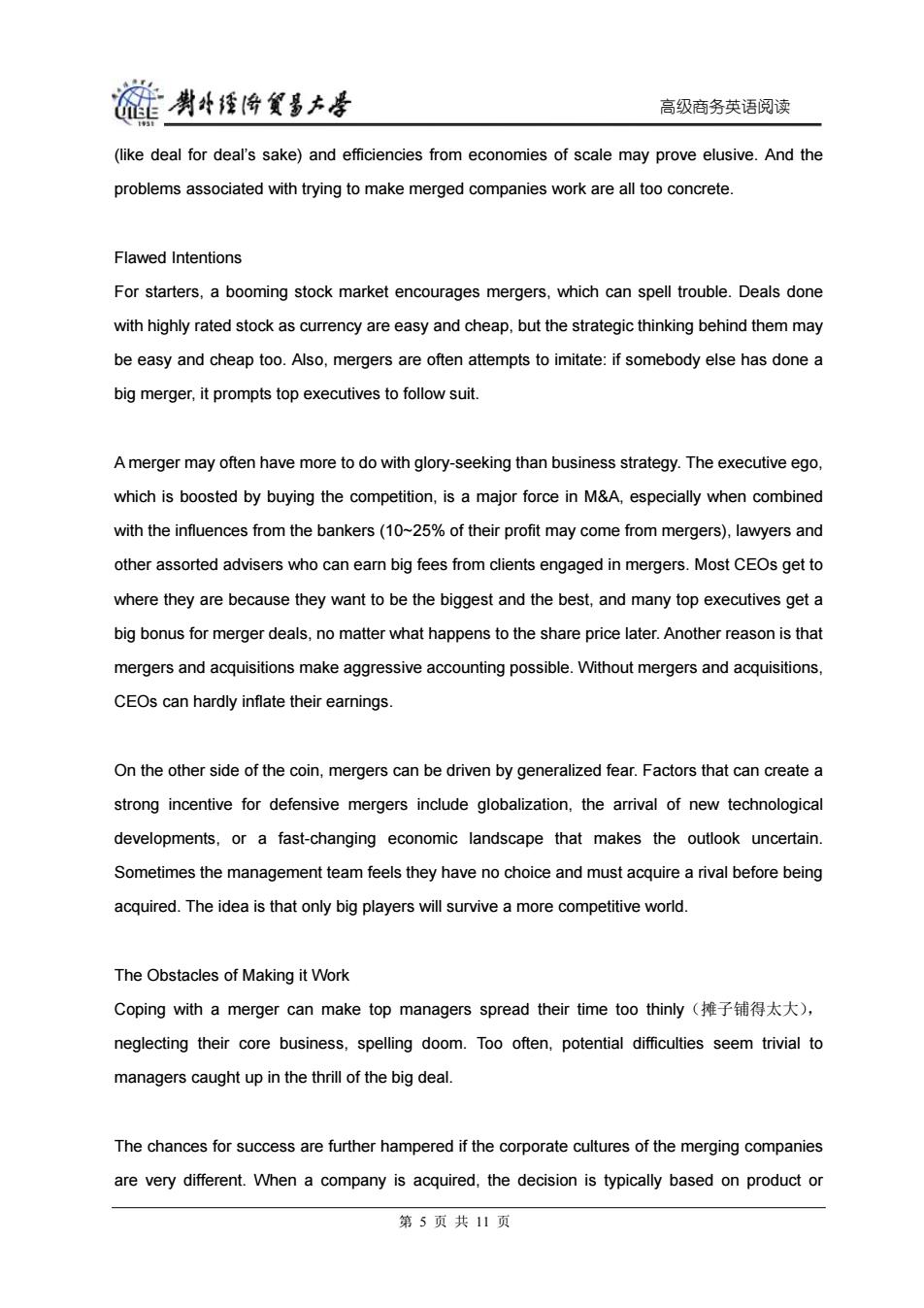
莲喇母矮将贸多大学 高级商务英语阅读 Chapter 13 Mergers Acquisitions 1.教学目的 通过本文的学习,使学生了解美国的最近一次合并和收购狂潮所带来的消极后果。 并购是一个全球现象,世界经济共经历过5次并购浪潮,它们分别是1897-1904,1916-29,1965-69, 1984-89以及20世纪90年代。特别是最后一次并购浪潮,持续时间长,并购涉及公司数量和金额 特别大,并给以后的经济造成较大影响。本文通过介绍并购的基本常识,结合语言的学习,增强学 生对上述内容的英语表达能力。 l.教学计划 拟使用六课时完成本课内容。二课时介绍并购相关知识及相关内容,三个课时用于课文讲解及难点、 重点讨论,最后一个课时就与课文相关的问题(如:中外并购的不同点和相同处,为什么亏损的上 市公司总是有人出高价收购等)展开讨论。 川.教学方法: 以学生为中心,通过师生互动、各抒己见的方式理解和认识课文中涉及到的问题(包括知识点和语 言方面的问题)。 IV.背景知识 1.Mergers and Acquisitions Definition Although they are often uttered in the same breath and used as though they were synonymous,the terms "merger"and "acquisition"are different things in their strict sense. When a company takes over another one and clearly becomes the new owner,the purchase is called an acquisition (also called takeover or buyout).From a legal point of view,the target company ceases to exist and the buyer"swallows"the business. 第1页共11页
高级商务英语阅读 Chapter 13 Mergers & Acquisitions I.教学目的 通过本文的学习,使学生了解美国的最近一次合并和收购狂潮所带来的消极后果。 并购是一个全球现象,世界经济共经历过 5 次并购浪潮,它们分别是 1897-1904, 1916-29, 1965-69, 1984-89 以及 20 世纪 90 年代。特别是最后一次并购浪潮,持续时间长,并购涉及公司数量和金额 特别大,并给以后的经济造成较大影响。本文通过介绍并购的基本常识,结合语言的学习,增强学 生对上述内容的英语表达能力。 II.教学计划 拟使用六课时完成本课内容。二课时介绍并购相关知识及相关内容,三个课时用于课文讲解及难点、 重点讨论,最后一个课时就与课文相关的问题(如:中外并购的不同点和相同处,为什么亏损的上 市公司总是有人出高价收购等)展开讨论。 III.教学方法: 以学生为中心,通过师生互动、各抒己见的方式理解和认识课文中涉及到的问题(包括知识点和语 言方面的问题)。 IV.背景知识 1. Mergers and Acquisitions Definition Although they are often uttered in the same breath and used as though they were synonymous, the terms "merger" and "acquisition" are different things in their strict sense. When a company takes over another one and clearly becomes the new owner, the purchase is called an acquisition (also called takeover or buyout). From a legal point of view, the target company ceases to exist and the buyer "swallows" the business. 第 1 页 共 11 页

链男牛经海食多大学 高级商务英语阅读 In the pure sense of the term,a merger happens when two firms,often about the same size,agree to go forward as a new single company rather than remain separately owned and operated.This kind of action is more precisely referred to as a"merger of equals."Both companies'stocks are surrendered,and new company stock is issued in its place(新设合并). In practice,however,actual mergers of equals are very rare.Often,one company will buy another and,as part of the deal's terms,simply allow the acquired firm to proclaim that the action is a merger,even if it's technically an acquisition.Being bought out often carries negative connotations. By using the term"merger,"dealmakers and top managers try to make the takeover more palatable to the target company.(吸收合并) A purchase deal will also be called a merger when both CEOs agree that joining together in business is in the best interests of both their companies.But when the deal is resisted-that is, when the target company does not want to be purchased-it is always regarded as an acquisition. So,whether a purchase is considered a merger or an acquisition really depends on whether the purchase is friendly or hostile and how it is announced.In other words,the real difference lies in how the purchase is communicated to and received by the target company's board of directors, employees and shareholders. From the perspective of business structures,there are a whole host of different mergers.Here are a few types,distinguished by the relationship between the two companies that are merging: Horizontal merger(横向合并)Two companies that are in direct competition in the same product lines and markets.Horizontal integration often raises antitrust concerns,as the combined firm will have a larger market share than either firm did before merging. Vertical merger(纵向合并)Merging with a company at a different stage in the production process,for instance,a car maker merging with a car retailer or a parts supplier.Unlike horizontal integration,it is likely to raise antitrust concerns only if one of the companies already enjoys some monopoly power,which the deal might allow it to extend into a new market. 第2页共11页
高级商务英语阅读 In the pure sense of the term, a merger happens when two firms, often about the same size, agree to go forward as a new single company rather than remain separately owned and operated. This kind of action is more precisely referred to as a "merger of equals." Both companies' stocks are surrendered, and new company stock is issued in its place(新设合并). In practice, however, actual mergers of equals are very rare. Often, one company will buy another and, as part of the deal's terms, simply allow the acquired firm to proclaim that the action is a merger, even if it's technically an acquisition. Being bought out often carries negative connotations. By using the term "merger," dealmakers and top managers try to make the takeover more palatable to the target company. (吸收合并) A purchase deal will also be called a merger when both CEOs agree that joining together in business is in the best interests of both their companies. But when the deal is resisted—that is, when the target company does not want to be purchased—it is always regarded as an acquisition. So, whether a purchase is considered a merger or an acquisition really depends on whether the purchase is friendly or hostile and how it is announced. In other words, the real difference lies in how the purchase is communicated to and received by the target company's board of directors, employees and shareholders. From the perspective of business structures, there are a whole host of different mergers. Here are a few types, distinguished by the relationship between the two companies that are merging: Horizontal merger(横向合并) Two companies that are in direct competition in the same product lines and markets. Horizontal integration often raises antitrust concerns, as the combined firm will have a larger market share than either firm did before merging. Vertical merger(纵向合并) Merging with a company at a different stage in the production process, for instance, a car maker merging with a car retailer or a parts supplier. Unlike horizontal integration, it is likely to raise antitrust concerns only if one of the companies already enjoys some monopoly power, which the deal might allow it to extend into a new market. 第 2 页 共 11 页

能男华经悔贸多本学 高级商务英语阅读 Acquisitions All acquisitions involve one firm purchasing another-there is no exchanging of stock or consolidating as a new company.Acquisitions can be congenial,with all parties feeling satisfied with the deal.Acquisitions can also become hostile. A special type of acquisition worth mentioning is called reverse merger(借壳上市),a deal that enables a private company to get publicly-listed (in a relatively short time period.A reverse merger occurs when a private company that has strong prospects and is eager to raise financing buys a publicly--listed shell company(空壳公司),usually one with no business and limited assets. The private company reverse merges into the public company,and together they become an entirely new public corporation with tradable shares. In an acquisition,as well as in merger deals,a company can buy another company with cash,with stock,or a combination of the two. Regardless of their category or structure,all mergers and acquisitions have one common goal: they are all meant to create synergy(协同优势)that makes the value of the combined companies greater than the sum of the two parts.The success of a merger or acquisition depends on how well this synergy is achieved. Synergy is the magic force that allows for enhanced cost efficiencies of the new business.Synergy takes the form of revenue enhancement and cost savings.By merging,the companies hope to benefit from the following: Staff reductions-As every employee knows,mergers tend to mean job losses.Consider all the money saved from reducing the number of staff members from accounting,marketing and other departments.Job cuts will also include the former CEO,who typically leaves with a compensation package.(薪酬包) Economies of scale-Yes,size matters.Whether it's purchasing stationery or a new corporate IT 第3页共11页
高级商务英语阅读 Acquisitions All acquisitions involve one firm purchasing another—there is no exchanging of stock or consolidating as a new company. Acquisitions can be congenial, with all parties feeling satisfied with the deal. Acquisitions can also become hostile. A special type of acquisition worth mentioning is called reverse merger(借壳上市),a deal that enables a private company to get publicly-listed(上市) in a relatively short time period. A reverse merger occurs when a private company that has strong prospects and is eager to raise financing buys a publicly-listed shell company(空壳公司),usually one with no business and limited assets. The private company reverse merges into the public company, and together they become an entirely new public corporation with tradable shares. In an acquisition, as well as in merger deals, a company can buy another company with cash, with stock, or a combination of the two. Regardless of their category or structure, all mergers and acquisitions have one common goal: they are all meant to create synergy(协同优势)that makes the value of the combined companies greater than the sum of the two parts. The success of a merger or acquisition depends on how well this synergy is achieved. Synergy is the magic force that allows for enhanced cost efficiencies of the new business. Synergy takes the form of revenue enhancement and cost savings. By merging, the companies hope to benefit from the following: Staff reductions - As every employee knows, mergers tend to mean job losses. Consider all the money saved from reducing the number of staff members from accounting, marketing and other departments. Job cuts will also include the former CEO, who typically leaves with a compensation package.(薪酬包) Economies of scale - Yes, size matters. Whether it's purchasing stationery or a new corporate IT 第 3 页 共 11 页

碰剥将多大是 高级商务英语阅读 system,a bigger company placing the orders can save more on costs.Mergers also translate into bigger purchasing power to buy equipment or office supplies-when placing larger orders, companies have a better position to negotiate price with their suppliers. Acquiring new technology-To stay competitive,companies need to stay on top of technological developments and their business applications.By buying a smaller company with unique technologies,a large company can keep or develop a competitive edge. Improved market reach and industry visibility-Companies buy companies to increase markets and grow revenues and earnings.A merge may expand two companies'marketing and distribution, giving them new sales opportunities.A merger can also improve a company's standing in the investment community:bigger firms often have an easier time raising capital than smaller ones That said,achieving synergy is easier said than done--it is not automatically realized once two companies merge.Sure,there ought to be economies of scale when two businesses are combined, but sometimes it works in reverse.In many cases,one and one add up to less than two. Sadly,synergy opportunities may exist only in the minds of the corporate leaders and the dealmakers.Where there is no value to be created,the CEO and investment bankers--who have much to gain from a successful M&A deal--will try to build up the image of enhanced value(usually by means of aggressive accounting).The market,however,eventually sees through this and penalizes the company by assigning it a discounted share price. Why M&A Can Fail It's no secret that plenty of mergers don't work.Those who advocate mergers will argue that the merger will cut costs or boost revenues by more than enough to justify the price premium.It can sound so simple:just combine computer systems,merge a few departments,use sheer size to force down the price of supplies,and the merged giant should be more profitable than its parts.In theory,1+1=3 sounds great,but in practice,things can go awry. Historical trends show that roughly two thirds of big mergers will disappoint on their own terms, which means they will lose value on the stock market.Motivations behind mergers can be flawed 第4页共11页
高级商务英语阅读 system, a bigger company placing the orders can save more on costs. Mergers also translate into bigger purchasing power to buy equipment or office supplies--when placing larger orders, companies have a better position to negotiate price with their suppliers. Acquiring new technology - To stay competitive, companies need to stay on top of technological developments and their business applications. By buying a smaller company with unique technologies, a large company can keep or develop a competitive edge. Improved market reach and industry visibility - Companies buy companies to increase markets and grow revenues and earnings. A merge may expand two companies' marketing and distribution, giving them new sales opportunities. A merger can also improve a company's standing in the investment community: bigger firms often have an easier time raising capital than smaller ones. That said, achieving synergy is easier said than done--it is not automatically realized once two companies merge. Sure, there ought to be economies of scale when two businesses are combined, but sometimes it works in reverse. In many cases, one and one add up to less than two. Sadly, synergy opportunities may exist only in the minds of the corporate leaders and the dealmakers. Where there is no value to be created, the CEO and investment bankers--who have much to gain from a successful M&A deal--will try to build up the image of enhanced value (usually by means of aggressive accounting). The market, however, eventually sees through this and penalizes the company by assigning it a discounted share price. Why M&A Can Fail It's no secret that plenty of mergers don't work. Those who advocate mergers will argue that the merger will cut costs or boost revenues by more than enough to justify the price premium. It can sound so simple: just combine computer systems, merge a few departments, use sheer size to force down the price of supplies, and the merged giant should be more profitable than its parts. In theory, 1+1 = 3 sounds great, but in practice, things can go awry. Historical trends show that roughly two thirds of big mergers will disappoint on their own terms, which means they will lose value on the stock market. Motivations behind mergers can be flawed 第 4 页 共 11 页

链喇4哈餐多方孝 高级商务英语阅读 (like deal for deal's sake)and efficiencies from economies of scale may prove elusive.And the problems associated with trying to make merged companies work are all too concrete. Flawed Intentions For starters,a booming stock market encourages mergers,which can spell trouble.Deals done with highly rated stock as currency are easy and cheap,but the strategic thinking behind them may be easy and cheap too.Also,mergers are often attempts to imitate:if somebody else has done a big merger,it prompts top executives to follow suit. A merger may often have more to do with glory-seeking than business strategy.The executive ego, which is boosted by buying the competition,is a major force in M&A,especially when combined with the influences from the bankers(10~25%of their profit may come from mergers),lawyers and other assorted advisers who can earn big fees from clients engaged in mergers.Most CEOs get to where they are because they want to be the biggest and the best,and many top executives get a big bonus for merger deals,no matter what happens to the share price later.Another reason is that mergers and acquisitions make aggressive accounting possible.Without mergers and acquisitions, CEOs can hardly inflate their earnings. On the other side of the coin,mergers can be driven by generalized fear.Factors that can create a strong incentive for defensive mergers include globalization,the arrival of new technological developments,or a fast-changing economic landscape that makes the outlook uncertain. Sometimes the management team feels they have no choice and must acquire a rival before being acquired.The idea is that only big players will survive a more competitive world. The Obstacles of Making it Work Coping with a merger can make top managers spread their time too thinly(摊子铺得太大), neglecting their core business,spelling doom.Too often,potential difficulties seem trivial to managers caught up in the thrill of the big deal. The chances for success are further hampered if the corporate cultures of the merging companies are very different.When a company is acquired,the decision is typically based on product or 第5页共11页
高级商务英语阅读 (like deal for deal’s sake) and efficiencies from economies of scale may prove elusive. And the problems associated with trying to make merged companies work are all too concrete. Flawed Intentions For starters, a booming stock market encourages mergers, which can spell trouble. Deals done with highly rated stock as currency are easy and cheap, but the strategic thinking behind them may be easy and cheap too. Also, mergers are often attempts to imitate: if somebody else has done a big merger, it prompts top executives to follow suit. A merger may often have more to do with glory-seeking than business strategy. The executive ego, which is boosted by buying the competition, is a major force in M&A, especially when combined with the influences from the bankers (10~25% of their profit may come from mergers), lawyers and other assorted advisers who can earn big fees from clients engaged in mergers. Most CEOs get to where they are because they want to be the biggest and the best, and many top executives get a big bonus for merger deals, no matter what happens to the share price later. Another reason is that mergers and acquisitions make aggressive accounting possible. Without mergers and acquisitions, CEOs can hardly inflate their earnings. On the other side of the coin, mergers can be driven by generalized fear. Factors that can create a strong incentive for defensive mergers include globalization, the arrival of new technological developments, or a fast-changing economic landscape that makes the outlook uncertain. Sometimes the management team feels they have no choice and must acquire a rival before being acquired. The idea is that only big players will survive a more competitive world. The Obstacles of Making it Work Coping with a merger can make top managers spread their time too thinly(摊子铺得太大), neglecting their core business, spelling doom. Too often, potential difficulties seem trivial to managers caught up in the thrill of the big deal. The chances for success are further hampered if the corporate cultures of the merging companies are very different. When a company is acquired, the decision is typically based on product or 第 5 页 共 11 页